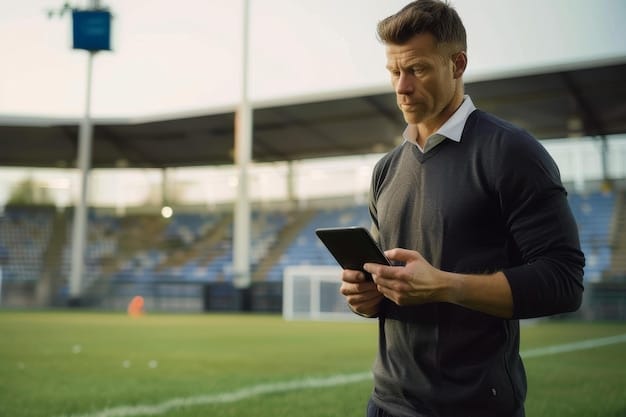How 5G is Revolutionizing US Soccer Performance by 2025

The advent of 5G connectivity is poised to fundamentally transform real-time player performance analysis in US soccer leagues by 2025, enabling unprecedented data capture and immediate insights for coaches and athletes.
The landscape of professional sports is constantly evolving, driven by innovation. In the realm of soccer, the quest for a competitive edge has always been paramount, and technology often holds the key. By 2025, expect a seismic shift in how performance is analyzed, as 5G is fundamentally revolutionizing real-time player performance analysis in the US soccer leagues, unlocking new frontiers in strategic insight and athlete development.
The Evolution of Performance Analytics in Soccer
Performance analysis in soccer has come a long way from mere post-match video reviews. Initially, coaches relied on subjective observations and basic statistics like goals and assists. Over time, advancements in video technology allowed for more detailed breakdowns of player movement and tactical execution. The introduction of GPS trackers and wearable sensors marked a significant leap, providing objective data on physical metrics such as speed, distance covered, and heart rate. However, these systems often faced limitations regarding data transfer speeds and latency, particularly when attempting to provide insights in real time.
The progression has been driven by a relentless pursuit of deeper understanding into every facet of gameplay. From rudimentary notepads to sophisticated tracking systems, the goal has remained consistent: to quantify the unquantifiable and gain an objective understanding of subjective performances. The challenge, however, has always been the speed at which this data can be collected, processed, and, most critically, delivered back to coaches and players in a timely manner. Traditional Wi-Fi and even earlier cellular networks simply couldn’t handle the sheer volume and velocity of data required for true real-time analysis on a large scale.
Early Adopters and Current Challenges
Many professional soccer clubs in the US have already embraced various forms of performance analytics, investing in specialized software and hardware. They collect vast amounts of data, from tactical movements to physiological responses. Yet, a common bottleneck persists: the transmission of this data from the field to the analytical dashboards with minimal delay.
- Latency Issues: Significant time lags between data collection and analysis hindered immediate decision-making during matches.
- Bandwidth Limitations: Large data packets from multiple sensors struggling to transfer efficiently over existing networks.
- Hardware Constraints: Dependence on local processing units or less robust wireless solutions.
These challenges meant that much of the detailed analysis remained confined to post-match debriefings, limiting its utility for in-game adjustments or immediate feedback to players. While valuable for long-term player development and strategic planning, the ‘real-time’ aspect was more aspirational than actual. The ability to intervene during active play based on live data has remained largely out of reach for most teams. This is precisely where 5G is poised to make its most profound impact, transforming a reactive analytical approach into a proactive one.
The current state, while advanced compared to prior decades, is still a compromise between detail and immediacy. Teams often choose between comprehensive data that arrives late or superficial data available quickly. The promise of 5G is to bridge this gap, offering both depth and speed simultaneously.
5G’s Core Capabilities Driving Sports Innovation
The fifth generation of cellular technology, 5G, isn’t just a faster version of 4G; it represents a paradigm shift in network capabilities. Its fundamental attributes directly address the limitations historically faced by sports performance analytics, paving the way for unprecedented levels of real-time data flow and actionable insights. Understanding these core capabilities is crucial to grasp the depth of its revolutionary potential. It’s the combination of speed, reduced latency, and massive connectivity that makes 5G particularly transformative for data-intensive applications like real-time sports tracking.
Unprecedented Speed and Bandwidth
One of 5G’s most touted features is its incredibly high peak speeds, capable of reaching 10 gigabits per second (Gbps) in ideal conditions, significantly surpassing 4G’s capabilities. This immense bandwidth means that massive amounts of data—from multiple high-resolution cameras to numerous wearable sensors—can be transmitted almost instantaneously. Imagine data from 22 players, each wearing several sensors, all streaming information concurrently without degradation. This ensures that every nuance of movement, every physiological response, and every tactical decision can be captured and transferred without delay, providing a complete and rich dataset.
The sheer volume of data that can be moved per second opens up possibilities that were previously impossible. Forget about lag or data bottlenecks; 5G creates a superhighway for information. This isn’t just about faster downloads; it’s about the ability to handle an unprecedented density of simultaneous data streams, essential for a sport like soccer where multiple events unfold every second across the entire field.
Ultra-Low Latency
Perhaps even more critical than speed for real-time applications is 5G’s ultra-low latency, which can drop to as low as one millisecond. Latency refers to the time it takes for data to travel from its source to its destination and back. In the context of performance analysis, this means the delay between a player making a movement and that movement being registered, processed, and displayed on an analyst’s screen is virtually negligible. This near-instantaneous feedback loop changes the game entirely.
- Immediate Feedback: Coaches can see critical events unfold and analyze them within seconds.
- In-Game Adjustments: Enables coaches to make tactical changes based on current performance data during a match.
- Player Intervention: Potential for real-time guidance to players based on their live metrics.
This minimal delay makes ‘real-time’ truly real. No more guessing, no more waiting until halftime. Decisions can be made on the fly, directly influenced by precise data, fundamentally altering coaching strategies and player development.
Massive Machine-Type Communications (MMTC)
Beyond speed and latency, 5G excels in its capacity for Massive Machine-Type Communications (MMTC). This capability allows 5G networks to connect a vast number of devices simultaneously within a small geographical area without compromising performance. For sports, this translates to the ability to track every player on the field, along with potentially the ball, environmental sensors, and even smart stadium infrastructure, all interconnected and communicating seamlessly. This density of connectivity is vital for capturing a holistic view of player and team performance.
Each sensor, each camera, each data point can join the network without overloading it, ensuring a robust and reliable data stream from every source. This creates an unparalleled ecosystem for data collection that transforms the playing field into a living laboratory. The network becomes capable of supporting an intricate web of interconnected devices crucial for comprehensive performance monitoring.
Real-Time Data Streams: What 5G Unlocks
The foundational capabilities of 5G—its speed, low latency, and capacity for massive connections—translate directly into transformational changes for real-time data streams in US soccer. These aren’t just incremental improvements; they represent a fundamental shift in how data is collected, processed, and utilized, moving from reactive analysis to proactive, in-the-moment decision-making. The ability to collect and interpret vast amounts of highly granular data instantaneously will redefine the analytical landscape.
Enhanced Player Tracking and Biometrics
With 5G, the accuracy and immediacy of player tracking data reach new heights. GPS and inertial measurement unit (IMU) sensors integrated into player vests or even smart equipment can transmit incredibly precise positional data multiple times per second. This means every sprint, every sudden change of direction, every tactical movement can be captured with unparalleled fidelity. Simultaneously, biometric data from heart rate monitors, sweat sensors, and even muscle activity trackers can be streamed live.
This allows performance analysts to monitor not just where a player is, but also their physiological state in real-time. Are they fatigued? Are their biomechanics showing signs of stress? Such insights enable proactive interventions, potentially reducing injury risk and optimizing substitution strategies. The sheer volume of raw data from multiple synchronized sensors, all transmitting concurrently, is only feasible with 5G’s robust infrastructure. This real-time biometric feedback provides an invaluable layer of insight beyond mere movement patterns.
Live Tactical Analysis
Coaches and analysts often make decisions based on what they see and their experience, but 5G empowers them with objective, live tactical insights. High-definition cameras, linked via 5G, can feed video streams directly into sophisticated AI-powered analytical software. This software can then identify complex tactical patterns, player formations, space occupation, and even predict potential plays as they unfold. The ultra-low latency ensures that these analyses are available virtually instantly.
- Formation Analysis: Real-time mapping of team shapes and how they adapt to opposition.
- Pressing Intensity: Quantifying collective and individual pressing efforts to inform tactical adjustments.
- Pass Completion Networks: Visualizing passing patterns and identifying weak links or effective combinations mid-game.
Imagine a coach on the sideline receiving an alert that their defensive line is dropping too deep, or that a specific attacking channel is being under-utilized, all based on live data. This enables dynamic adjustment of strategies rather than waiting for halftime. It’s no longer about reviewing what happened, but about influencing what is happening and what will happen.

AI and Machine Learning: Supercharging 5G Data
While 5G provides the unparalleled pipeline for data, it’s Artificial Intelligence (AI) and Machine Learning (ML) that transform this tidal wave of raw information into actionable intelligence. Without these powerful computational capabilities, the sheer volume and velocity of 5G-enabled data would be overwhelming, reducing its utility. AI and ML algorithms are the engines that will extract meaning, identify patterns, and predict outcomes from the incredibly rich datasets streamable via 5G, essentially supercharging the analytical process. They are the interpreters of the vast datasets flowing in a 5G environment, making sense of the chaos.
Predictive Analytics and Injury Prevention
One of the most exciting applications of AI and ML, when combined with 5G, is in predictive analytics. By continuously processing real-time biometric and movement data, AI models can learn to identify subtle patterns that precede fatigue or potential injuries. For instance, a slight alteration in running gait, a sustained elevated heart rate during a low-intensity period, or an unusual sequence of impacts could trigger an alert. This changes injury management from reactive to proactive, potentially saving careers and maximizing player availability.
Coaches and medical staff can receive instant warnings, allowing them to intervene—whether by substituting a player, adjusting training loads, or providing immediate medical assessment—before a minor strain escalates into a serious injury. This ability to predict and prevent, driven by real-time data analysis, is a game-changer for athlete welfare and team performance.
The AI models continually learn from historical data, improving their predictive accuracy over time. This iterative learning process ensures that the insights provided become increasingly refined and specific to individual player profiles, leading to highly personalized preventative strategies.
Optimizing Training Regimens
The insights generated by AI and ML from 5G data extend beyond match day performance to revolutionizing daily training. Coaches can gain a real-time understanding of how players are responding to different drills and workloads. Is a player effectively executing a specific tactical instruction? Are they maintaining the required intensity levels? Are they recovering sufficiently between sessions?
AI can analyze individual player performance against benchmarks, identifying areas for improvement and suggesting personalized training drills. This level of personalized feedback, delivered instantly, allows for dynamic adjustments to training plans, ensuring every session is optimized for maximum development and minimal risk. It moves away from a one-size-fits-all approach to highly bespoke training regimens.
For example, if AI observes a dip in a specific player’s acceleration capacity during a drill, it could recommend specific conditioning exercises or a period of reduced load. Similarly, if a tactic isn’t being executed effectively, AI can highlight the precise players and moments where the breakdown occurs. This data-driven approach to training ensures that every minute on the field is purposefully spent maximizing player potential.
Automated Scouting and Opponent Analysis
The combination of 5G, AI, and comprehensive player tracking can also automate and enhance scouting and opponent analysis. Instead of manually reviewing countless hours of video, AI algorithms can process live match footage and statistical data to automatically identify key player tendencies, tactical patterns of opposing teams, and areas of strength and weakness. These insights can be generated during a match or shortly after, providing coaches with immediate, deep dives into upcoming opponents or in-game tactical shifts.
This allows scouting departments to be incredibly efficient, focusing human expertise on critical decisions rather than data aggregation. The AI can also generate hypothetical scenarios, simulating how different tactical adjustments might affect game outcomes, arming coaches with data-backed strategies. This level of analytical depth and speed will provide a significant competitive advantage to teams that embrace it fully.
By automating much of the tedious data processing, human analysts can spend more time on interpreting the nuances and formulating strategic responses. This synergy between human intelligence and AI-powered insights creates a highly sophisticated analytical framework, benefiting from both objective data and subjective experience.
Infrastructure and Implementation Challenges
While the promise of 5G in sports is immense, its full realization in US soccer leagues by 2025 comes with significant infrastructure and implementation challenges. It’s not simply a matter of flipping a switch; it requires substantial investment, coordination, and technical expertise to build and deploy the necessary systems. Overcoming these hurdles will be crucial for widespread adoption and the unlocking of 5G’s full analytical potential.
Stadium Connectivity and Edge Computing
To deliver true ultra-low latency and high bandwidth, 5G infrastructure needs to be pervasive within stadiums and training facilities. This involves deploying a dense network of 5G small cells and potentially dedicated private 5G networks. Furthermore, for real-time processing, much of the data analytics needs to happen at the “edge” of the network—meaning processing capabilities are located physically closer to the data source (e.g., within the stadium itself) rather than relying on distant cloud servers. This reduces transmission time and ensures near-instantaneous feedback.
The cost and complexity of installing such robust infrastructure in every stadium and training ground across US soccer leagues present a significant financial and logistical hurdle. Stadium retrofitting, fiber optic upgrades, and the strategic placement of 5G antennas will require substantial capital expenditure and technical planning. Without this localized processing power, the benefits of 5G’s low latency would be diminished, as data would still need to travel further for analysis.
Data Security and Privacy Concerns
The collection and transmission of vast amounts of highly personal player data—including biological and movement patterns—raise significant data security and privacy concerns. Leagues, teams, and technology providers must implement stringent cybersecurity measures to protect this sensitive information from breaches and unauthorized access. Compliance with data protection regulations will be paramount, and transparent policies regarding data usage and storage will need to be established to build trust with players and their associations.
- Data Encryption: Ensuring all data, both in transit and at rest, is securely encrypted.
- Access Control: Implementing strict protocols on who can access sensitive player data.
- Regulatory Compliance: Adhering to evolving data privacy laws and league-specific agreements.
Addressing these concerns proactively is not just a regulatory requirement but also a matter of ethical responsibility. Players need to be confident that their personal performance data is protected and used ethically. Secure systems and clear policies are essential for widespread adoption.
Integration with Existing Systems
Many US soccer teams already utilize various analytics platforms, legacy hardware, and coaching software. Integrating new 5G-enabled systems seamlessly with existing infrastructure will be a complex task. This requires interoperability between different technologies, potentially involving customized APIs (Application Programming Interfaces) and data standardization efforts. Compatibility issues could delay adoption or force teams to undertake costly overhauls of their current setups.
A unified data architecture will be key to ensuring that insights generated from 5G data can be effortlessly combined with historical performance data, medical records, and scouting reports. Without proper integration, the full potential of 5G’s data streams might remain siloed, hindering a holistic analytical approach. Leagues might need to establish common data standards to facilitate this integration across multiple teams and vendors.
Impact on Player Development and Scouting
The revolutionary capabilities of 5G, particularly when amplified by AI and sophisticated analytics, extend far beyond match-day strategies. They are poised to fundamentally reshape the long-term processes of player development from youth academies to the professional ranks, and to revolutionize how talent is identified and nurtured through modern scouting. This isn’t just about winning the next game; it’s about building sustainable success through data-driven talent management. The insights gained from precise, real-time performance data will create an unprecedented level of personalized development plans.
Personalized Training Regimens
With real-time access to a player’s physical, technical, and tactical performance data during training sessions, coaches can develop highly personalized training regimens. AI algorithms can identify specific areas where a player needs improvement—be it acceleration, passing accuracy under pressure, spatial awareness, or defensive positioning. Instead of generic drills, players can engage in exercises specifically tailored to address their weaknesses and amplify their strengths, all based on objective, quantifiable data streamed instantly via 5G.
This allows for immediate feedback to players on their execution, enabling faster skill acquisition. If a player is struggling with a particular movement pattern, coaches can intervene instantly with precise, data-backed advice. This level of granular, personalized attention, previously only available to a select few, can now be scaled across entire academies and senior teams, accelerating development curves significantly.
The continuous monitoring also allows for real-time adjustments to training loads, ensuring players are optimally challenged without being overtrained, further reducing injury risk and promoting consistent progress. It transforms coaching into a truly data-informed, tailored process.
Objective Player Assessment for Scouting
Traditional scouting has often relied on subjective observations and limited metrics. 5G, combined with advanced analytics, introduces a new era of objective player assessment. Scouts can access comprehensive data sets on potential recruits, not just from curated highlights but from full matches and training sessions, streamed live or near-live. This includes highly detailed metrics on technical proficiency, tactical understanding, physical output, and even decision-making under pressure.
- Quantified Technical Skills: Precise data on passing accuracy, shooting power, dribbling success rate, etc.
- Tactical Intelligence: Metrics on off-the-ball movement, defensive positioning, and tactical adherence.
- Physical Resilience: Objective data on stamina, recovery rates, and response to fatigue.
This data-driven approach minimizes bias and allows clubs to identify hidden gems or scout specific player profiles that perfectly fit their strategic needs. It democratizes access to comprehensive performance insights, leveling the playing field for recruitment and making talent identification far more precise and verifiable. The ability to compare players objectively across different leagues and playing environments becomes a real possibility, moving away from reliance purely on highlight reels or limited live viewings.

Fan Engagement and Media Experience
The revolution brought by 5G in US soccer extends beyond the pitch and training ground, fundamentally transforming how fans interact with the sport and how media delivers content. The enhanced connectivity and data capabilities will create immersive, personalized, and interactive experiences, driving deeper engagement and potentially attracting new audiences to the sport. It’s about bringing the data and insights traditionally reserved for coaches directly to the viewers in compelling ways.
Immersive Broadcasts and AR/VR Experiences
5G’s high bandwidth and ultra-low latency enable unprecedented immersive broadcast experiences. Imagine watching a match from a player’s first-person perspective via a tiny camera, with the video streamed in real time without lag. Augmented Reality (AR) and Virtual Reality (VR) applications become truly viable, allowing fans to overlay live performance statistics directly onto their screens or immerse themselves in a virtual stadium environment from anywhere in the world.
Broadcasters can leverage 5G to deliver multiple camera angles, statistical overlays, and real-time player tracking data directly to viewers’ devices, allowing for a personalized viewing experience. Fans could choose to track their favorite player’s speed and distance covered live, or analyze team formations with interactive 3D graphics in real time from their living rooms. This level of dynamic, customizable content will redefine what it means to watch a soccer match.
The potential for experiencing a game as if you’re on the sidelines, or even as one of the players, becomes a reality. This elevates passive viewing into an active, analytical, and highly engaging experience, fostering a deeper connection with the sport and its athletes.
Personalized Fan Content and Betting Analytics
The vast amounts of data collected via 5G can be leveraged to create highly personalized content for fans. Imagine an app that provides real-time alerts tailored to your favorite player’s performance, or highlights key tactical battles involving your preferred team. From customized highlight reels driven by AI to in-depth statistical breakdowns delivered instantly, 5G fuels a new era of fan-centric digital experiences.
Furthermore, for the burgeoning sports betting market, 5G enables low-latency data feeds for in-play betting. This allows betting platforms to offer more dynamic and responsive odds based on real-time events, potentially creating a more engaging and immediate betting experience. Data-rich analytics, previously reserved for professional analysts, can be packaged for fans interested in deeper statistical insights for their betting strategies, all delivered with minimal delay. This creates an enriched environment for both casual fans and serious enthusiasts.
The ability to deliver real-time insights means that fans can be their own analysts, making informed predictions and engaging with the game on a much more cerebral level. This interactivity and personalization will be key drivers of future fan engagement, making every match a unique, data-rich spectacle.
The Future Landscape of US Soccer by 2025
By 2025, the influence of 5G on US soccer leagues will be palpable, reshaping not just how games are played and analyzed, but how teams operate and how fans engage. The shift will be from data being a post-facto analysis tool to an omnipresent, real-time guiding force. This future landscape envisions a sport where technology is seamlessly integrated into every facet, from player development to strategic decision-making, offering an unprecedented level of insight and precision. The competitive advantages will accrue to those who fully embrace and wisely leverage this technological transformation.
Enhanced Competitive Balance
As 5G-enabled analytics become more widespread, they could contribute to an enhanced competitive balance across US soccer leagues. While larger clubs might initially have an advantage in adopting the technology, the accessibility and scalability of 5G solutions mean that smaller teams could eventually gain access to similar levels of analytical insight. This democratization of high-quality data could empower more teams to optimize player performance, refine tactics, and make smarter recruitment decisions, leading to a more competitive and exciting league structure.
The gap in analytical capabilities between the technologically advanced and the less so will narrow, as the infrastructure costs eventually decrease and plug-and-play solutions become more common. This will force all teams to be more strategically astute, fostering a league where competitive success is increasingly tied to the intelligent application of data rather than just raw financial power.
New Coaching Paradigms
The influx of real-time 5G data will necessitate a new coaching paradigm. Coaches will transition from relying solely on intuition and experience to integrating data-driven insights seamlessly into their decision-making process. This doesn’t mean replacing human coaching acumen, but rather augmenting it with objective, granular information. Training for coaches will likely evolve to include data interpretation and the practical application of real-time analytics.
The ability to receive instant feedback on tactical shifts or individual player performances during a match will enable more dynamic and responsive coaching. This could lead to faster adaptations to opponent strategies, more effective substitutions, and a more tailored approach to player motivation and in-game guidance. Coaching will become a more scientific discipline, while retaining its human element of leadership and motivation.
Increased Investment in Sports Tech
The success and demonstrated benefits of 5G in US soccer will undoubtedly spur increased investment in sports technology across the board. Venture capital will flow into startups developing innovative 5G-compatible sensors, AI analytics platforms, and immersive fan experiences. This creates a virtuous cycle: more investment leads to more innovation, which further enhances the utility of 5G in sports, attracting even more investment.
Professional clubs, recognizing the competitive edge, will earmark larger portions of their budgets for technology infrastructure and specialist data analytics personnel. This trend will likely extend to youth academies and amateur leagues, slowly but surely integrating advanced data analysis into all levels of soccer. By 2025, the synergy between 5G and various sports technologies will likely have created a booming sub-industry focused on optimizing athletic performance and enhancing fan engagement.
| Key Point | Brief Description |
|---|---|
| 🚀 Speed & Latency | 5G offers ultra-fast data transfer and near-zero delay for instant insights. |
| 🧠 AI & Analytics | AI/ML transform raw 5G data into actionable insights for strategy and prevention. |
| 📈 Player Development | Personalized training and objective scouting enhanced by real-time metrics. |
| ⚽ Fan Engagement | Immersive broadcasts and personalized content drive deeper fan connection. |
Frequently Asked Questions
▼
5G’s main advantage is its ultra-low latency, allowing for near-instantaneous transmission of vast amounts of data from players and sensors. This means coaches and analysts can receive insights and make decisions in real time, directly impacting in-game strategy and player welfare without significant delay.
▼
5G will enable highly personalized training regimens. Coaches can monitor player performance metrics like speed, fatigue, and tactical execution in real time, allowing for immediate feedback and adjustments to drills. This data-driven approach will accelerate skill acquisition and minimize injury risk for athletes.
▼
Yes, significantly. By combining 5G’s real-time data streaming with AI and machine learning, predictive analytics models can identify subtle physiological changes or movement patterns that might indicate fatigue or an impending injury. This allows medical staff to intervene proactively, potentially preventing more serious issues.
▼
Absolutely. 5G bandwidth supports immersive experiences like multiple camera angles, AR/VR overlays displaying live player stats, and personalized content. Fans could virtually place themselves on the field or access specific player data in real time, creating a much more interactive and customized viewing experience.
▼
Key challenges include the significant investment required for stadium and training facility 5G infrastructure, ensuring robust data security and player privacy, and seamless integration with existing team analytics systems. While substantial, these hurdles are being addressed as the technology matures and becomes more accessible.
Conclusion
The integration of 5G technology into US soccer leagues by 2025 is not merely an upgrade; it is a fundamental redefinition of performance analysis. From the training ground to the stadium, 5G’s ultra-low latency, immense bandwidth, and massive connectivity will enable an unprecedented flow of real-time data. This data, when harnessed by sophisticated AI and machine learning algorithms, will shift the paradigm from reactive insights to proactive, in-the-moment decision-making for coaches, players, and medical staff. The ripple effects will be profound, enhancing player development through personalized regimens, revolutionizing scouting with objective metrics, and transforming fan engagement with immersive, interactive experiences. While infrastructure and data security challenges remain, the competitive advantage and tangible benefits offered by 5G will undoubtedly drive its widespread adoption, cementing its role as a game-changer in the evolution of professional soccer.





